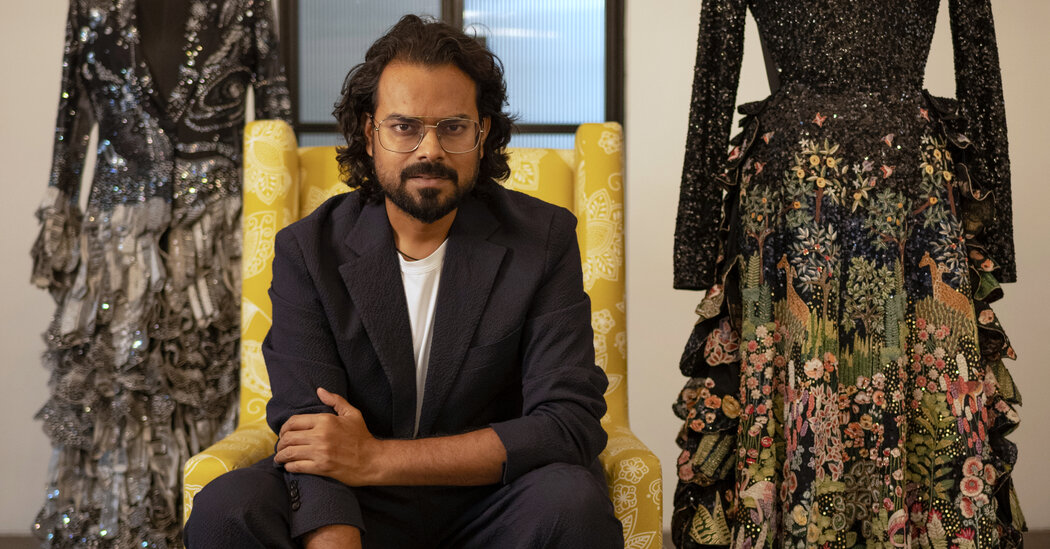
It took Rahul Mishra six years to sell his first bridal lehenga, a three-piece skirt, blouse and scarf ensemble from the Indian subcontinent. That was in 2017. Now, there’s an almost five-month wait to buy one.
In April, the 43-year-old fashion designer, who is based in Delhi, India, made headlines for dressing Zendaya in a shimmery blue sari at the opening of the Nita Mukesh Ambani Cultural Center in Mumbai. (He has also previously dressed Gigi Hadid, Viola Davis and Priyanka Chopra.) In 2020, he became the first Indian designer to show at Paris Haute Couture Week, and he has gone back every year since. He returns on July 3.
But there is also the booming retail side of his business, Mr. Mishra said, a huge chunk of which comes from weddings: designs for brides as well as the kurtas, pantsuits and saris for family members. Weddings are “red carpet” events for people who aren’t celebrities, he said — especially in Indian culture, where weddings often span multiple days, requiring many outfits for a long list of guests.
Mr. Mishra’s first venture creating a wedding wear fashion line was in 2012. And yet his unconventional focus on ivories, blues, pinks and even blacks for brides — over the traditional red — ultimately did not sell well. Shortly after, the line was discontinued.
However, he may have been ahead of his time. Nowadays, many South Asian brides no longer opt for red on their wedding days, said Aisha Rawji, the founder of an Indian bridal store called Kynah.
Mr. Mishra’s latest foray into wedding wear, starting in 2017, has proved more successful. While the designer remains ambivalent about red (“cliché,” he said), he seeks inspiration instead from the ancient Indian designs that used calico textile, an unbleached fabric made from cotton fibers.
“Everything was undyed and unbleached, so it would always have an off-white, ecru feel,” Mr. Mishra said. The brides who want Rahul Mishra lehengas, he said, enjoy the originality of the intricate embroidery and propulsive artisanal designs.
Wedding attire sales, which have increased dramatically since the Covid-19 pandemic, he said, help maintain employment for the 1,200 embroiderers he works with from communities across rural India. “What you do in couture is very fancy and doesn’t sell,” Mr. Mishra said. “It’s not going to end up creating so much employment, but the weddings are so powerful.”
Mr. Mishra grew up under humble conditions in Malhausi, a small village in Uttar Pradesh, India, where there was barely any electricity. While he always knew he wanted to be an artist, he stumbled upon design by accident. He applied to the National Institute of Design in Ahmedabad to become a cinematographer, but his application was rejected. So he enrolled in the apparel design program at the school instead. (His father, who had wanted him to become an engineer, didn’t speak to him for a year.)
As it turned out, Mr. Mishra was good at design. A department coordinator from his school submitted Mr. Mishra’s sketches to GenNext, a talent discovery program for Lakme Fashion Week in 2006, and he was selected. After that, he won a series of other awards, including the International Woolmark Prize in 2014. “I’ve been very lucky,” Mr. Mishra said.
His background, however, is more technical than fashion-oriented. For him, he said, design is a goal-oriented, problem-solving exercise. And one of his main goals throughout is to employ people in rural India so their families can make a living.
“I was very confused when I thought about fashion,” Mr. Mishra said. “I thought, ‘I want to change the world; I want to design something for people who are not doing well.’ But I never thought that fashion could be so powerful when you slow down the process of creating things.”
A more ethically paced production process has proved crucial for his ethos of “mindful luxury.” Mr. Mishra said that “the slowness is so powerful that it creates more participation for people who can work on creating that beautiful outfit.”
Almost all of his pieces are entirely handmade — each one takes anywhere from 1,000 to 8,000 hours to make, he said.
The theme for his show at Paris Haute Couture Week is “We, the People,” and it centers the embroiderers of his pieces — there are even figurines of artisans sewn into the clothes.
During a video interview, Mr. Mishra swiped through some of the designs. On one of them, there is a figurine of a tailor Mr. Mishra works closely with, Munir Ahmed: He is bent over with a needle and thread in hand.
“We were laughing; we’re making Munir bhai, the tailor, and he looks like a D.J., a cool guy,” he recalled, adding that his atelier in Noida, in the outskirts of Delhi, had been particularly lively as he and his team worked on this collection.
While Mr. Mishra still sees himself as a student in the fashion game, he said, his No. 1 goal as a creative director is to inspire the 250 people who work with him.
“Our studio is like a temple or mosque — we all are contributing to each other’s happiness,” Mr. Mishra said. “And we make good designs, so we get more orders and employ more and more people.”
He took off his glasses and wiped away his tears. “Sorry, I get really emotional about it,” he said.






